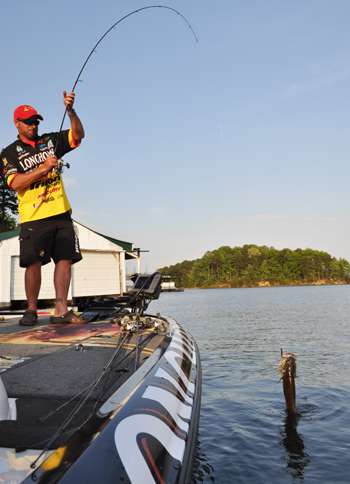
A system is defined as "a regularly interacting or interdependent group of items forming a unified whole." Usually these items are optimized together for the most efficient, practical and effective use of the system. On the water, a well-oiled system can translate to more effective fishing and more fish in the boat.
Jeff Kriet has developed a system of finesse fishing that has accounted for the majority of his winnings. While he doesn't have a name for it, it could be called the Squirrel System. It's his rod, reel, line, jighead, worm and presentation that act as a unified whole to make him competitive on the Elite circuit.
A rod fit for a Squirrel
Your rod is your underwater hand, feeling out the structure and lay of the bottom. With baits that move along the bottom, a sensitive rod is paramount. Kriet has designed a rod for Falcon that is ideal for shaky head fishing.
"The Squirrel rod is a 7-foot Cara T7 rod with a good amount of backbone and a soft tip, and that's the thing I like," he says. "When I get bit, I'm going to load that thing up and lean into it. The rod takes over for you."
Kriet uses 6- or 8-pound-test Hi-Seas fluorocarbon spooled on an Abu Garcia Soron spinning reel.
Squirrel Tail Worm for the Big Bite
The centerpiece of the Squirrel System is the Big Bite Bait Co. Squirrel Tail Worm. Kriet designed the worm after being dissatisfied with other finesse worms. He's very exacting about his worm shaking and knew exactly what he wanted out of a shaky worm.
"I always had a better shaky head worm in my mind. Just sitting around the house I thought of ways to make a superior worm," he says. "I got to thinking about it and found that what I wanted was a worm that didn't stand straight up; I wanted just the tail to stand up."
Kriet got in touch with Big Bite Bait Co. out of Eufaula, Ala., and shared his idea with them. The design used a regular finesse-style worm for the front half, a noodle section just aft of that, followed by a buoyant, bulbous tail. The "noodle section," as Kriet calls it, allows the tail to move and dance with the slightest action from the rod.
To make the tail section float, Big Bite added powdered glass. Kriet then added a color lineup to cover most every condition.
A Jewel of a head
Kriet's other gripe with shaky setups was the lackluster heads on the market. He poured his own to meet his needs. Eventually he got with Jewel Bait Co. out of Bakersfield, Mo., to create the Squirrel Head.
"The biggest problem with a lot of heads is that there is a flipping hook on them," he says. "You don't flip with 6- and 8-pound-test line, so why would you put a heavy hook on a shaky head you're using light line with?"
Another thing that Kriet wanted in his shaky jighead was a football-style head. The oblong shape skips better. He also wanted the line tie to be tight to the head. The Jewel jighead delivers all of this.
In all of his experience with shaky head fishing, Kriet found that Jewel's keeper is one of the best out there. It's a light barb that grabs and "locks" the worm into place.
"I throw a 1/8-ounce 90 percent of the time and a 1/16-ounce most of the rest of the time," he says. "If it's windy, I may go to 3/16 ounce, but that's rare. When you're finesse fishing you want to go with the lightest head you can get away with. If I feel I need bigger than 3/16 ounce, I use a jig. You don't need to be shaking a worm when it's that windy. You can catch 'em doing something else."
Work it right
Shaking the Squirrel System is fairly simple. However, it's also easily complicated.
"The most important things to remember are easy. First, don't engage the reel right after you cast it; you won't get the fall you want," Kriet advises. "Second, work it on a semi-slack line. You can see the strikes better when the line hops and you can still feel a strike. Lastly, don't use line that's too heavy. Six- or 8-pound test is all you should need, even when skipping it under docks."
Kriet says he doesn't use light line for visibility reasons, he uses it to get better action out of the worm. After the worm hits bottom, Kriet engages the reel then slowly drags the worm until he hits some kind of cover or structure. Once he feels it stop, he'll start gently shaking.
"I feel like this setup is just right. We've got a good deal going," he says. "There's not a lot I'm good at, but I feel I'm pretty decent at shaking a worm, and this setup is the perfect tool for the job."




